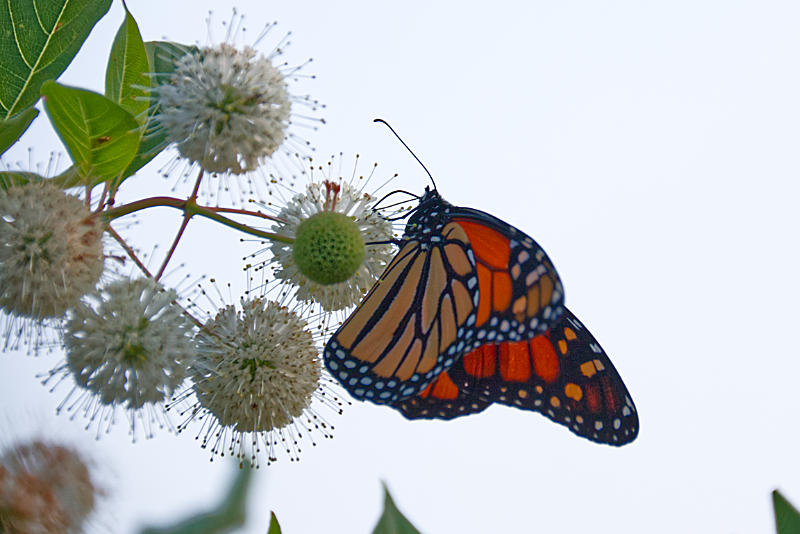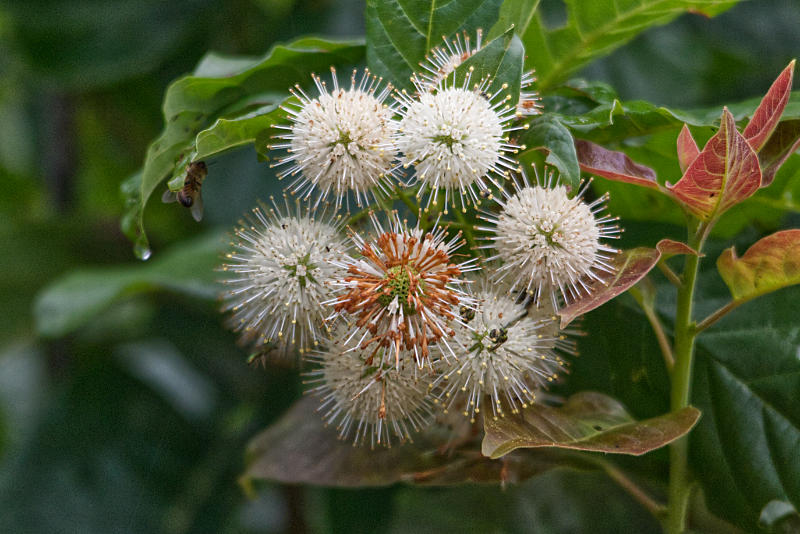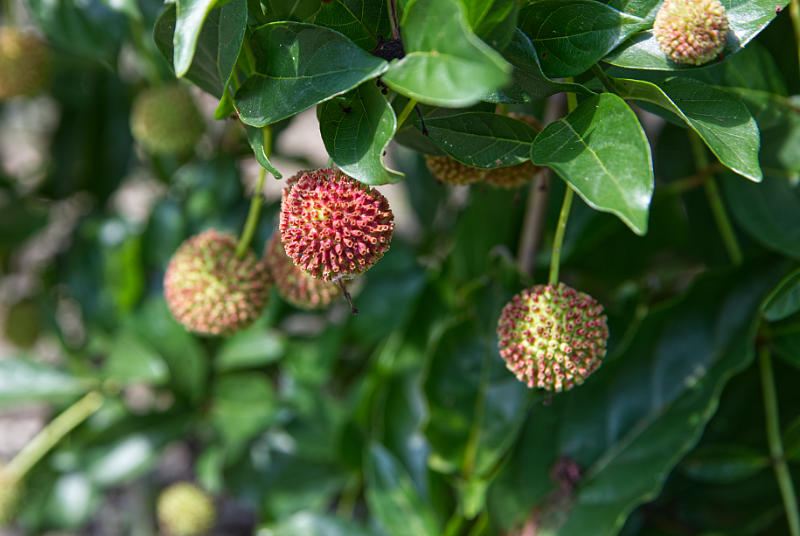
The Buttonbush plant is a popular species found in many low-lying wet areas, as well as gardens and landscapes across the United States. It’s an attractive and hardy plant with a variety of uses. In this article, I’ll discuss the characteristics, growth habits, and care of the Buttonbush plant. I’ll also provide helpful tips on how to grow and maintain this beautiful species.
What is a Buttonbush?
Buttonbush (Cephalanthus occidentalis) is a deciduous shrub native to North America. It has a range reaching from Quebec and Ontario in the north to Florida and Texas in the south. It grows in a variety of wetland habitats, including marshes, swamps, fens, bogs, and even along the banks of rivers, lakes, and streams. The plant grows to heights of up to 12 feet tall and up to 8 feet wide. It has a distinctive roundish shape, with arching branches and a multitude of small, white flowers. The flowers of the buttonbush are quite unique and are the main feature of the plant, as each flower consists of four or five petals arranged in a whorl and surrounded by a ring of long filaments. The flowers are fragrant and attract a variety of pollinators, including bees and butterflies. The flowers are also a valuable source of nectar for hummingbirds. The leaves of the buttonbush are opposite, simple, and lance-shaped. They are dark green with a smooth surface and are 1-3 inches in length. The fruit of the buttonbush is a round, greenish-brown, four-celled capsule about 1/3 inch in diameter. When ripe, the capsule splits open to release small, dark brown seeds. The seeds are edible and can be ground into flour or used as a substitute for coffee. Buttonbush is an attractive shrub and can be used in many different garden settings. It is tolerant of a wide range of soil conditions and is even salt tolerant, making it a great choice for beachside gardens. The flowers of the buttonbush add a unique touch to any garden and the plant can provide a natural habitat for birds and other wildlife.

Why is it called Buttonbush?
The plant gets its common name from the flower heads that resemble small buttons. Buttonbush is also a member of the Madder family (Rubiaceae). It is native to the wetlands and riverbanks of North America and is found in many areas of the eastern and southern United States. It is also found in a few areas of Central and South America. The buttonbush is an adaptable plant that can grow in a variety of habitats, including wetlands, woodlands, and open fields. It prefers moist, well-drained soils and full sun to partial shade. It is a popular choice for use in wetlands and naturalized landscapes. The buttonbush is a summer-blooming, nectar-producing plant that attracts bees, butterflies, and hummingbirds. Its flowers are quite fragrant and can provide a pleasant scent to a garden. Each flower has four to eight petals and is around 0.5–1 inch in diameter. The flowers are fragrant, attracting bees and other pollinators. The Buttonbush also produces bright red fruits around 1 inch in diameter. The fruits are edible, but not particularly tasty. The fruits provide food for many species of birds, mammals, and invertebrates. The buttonbush is an important plant for many reasons. It helps to create and protect valuable wetland habitats, provides food and shelter for wildlife, and can add beauty and fragrance to a garden. It is an easy-to-grow plant that can provide years of enjoyment for gardeners and wildlife alike.
Habitat and Growth Habits of Buttonbush
It typically grows in wetlands, such as swamps, riverbanks, and along ponds and lakes, and can also be found in moist woods or near streams. It is a hardy plant and can tolerate a variety of conditions, including drought. The buttonbush reaches an average height of 6-9 feet and has an upright, rounded habit. Its branches are reddish-brown in color and are densely covered in small, lance-shaped leaves that are dark green in summer and turn yellow in the fall. The shrub is known for its fragrant, white flowers that bloom in the summer and its bright, round, red-brown seed pods that are produced in the fall. Buttonbush prefers full sun to part shade in moist, acidic soil and can easily tolerate flooding. It is a low-maintenance plant that requires minimal pruning and enjoys the occasional light fertilization. It is also quite drought-tolerant once it is established. Buttonbush is a great choice for wildlife gardens and is a favorite food of many birds and animals. It is often used as an ornamental shrub in gardens and can also be planted in wet areas to help reduce erosion.
What are the Climate and Soil Preferences of the Buttonbush?
Buttonbush prefers rich, moist, humusy soil that is well-drained but can tolerate a wide range of soil types, including loamy sand and clay loam. It is drought tolerant but prefers regular water during dry spells. It will tolerate partial shade but will flower best in full sun. It is adaptable to varying pH levels ranging from acidic to alkaline. It is hardy in zones 4-9 and prefers a moderate to warm climate.

What are the Growth Habits?
Buttonbush is a fast-growing shrub and can be grown in a variety of soils, including clay, loam, and sand. It prefers full sun or partial shade and can tolerate wet conditions. It will grow best in moist, well-drained soils in an area where it is protected from strong winds. Buttonbush can be propagated from seed or cuttings. When propagating from seed, the seeds should be sown in the fall and allowed to stratify (cold-treated) over the winter before they are planted in the spring. When propagating from cuttings, the cuttings should be taken in the summer and planted in the fall. Buttonbush is generally low maintenance and drought tolerant, though it prefers consistent moisture. Pruning is recommended to maintain the desired shape and size of the shrub. It is also recommended to mulch the base of the plant to help conserve soil moisture and keep weeds at bay. Buttonbush is a beautiful, low-maintenance shrub that provides interest and color in the garden. Its fragrant flowers attract many pollinators and its dense growth habit can provide a pleasant screening effect.
What is the Lifespan?
When planning your garden it helps to know the anticipated lifespan of the plants you plan to plant. The lifespan of this species can vary depending on the climate, soil, and other environmental factors. Generally, the Buttonbush can live up to 20 years. In its early stages, the Buttonbush will produce small, white flowers that attract pollinators such as bees and butterflies. As it matures, the plant will reach heights of up to 12 feet and produce clusters of white, fragrant flowers. The flowers will last through the summer months, and then the plant will produce seed heads, which can remain on the plant through the winter. The Buttonbush is an easy plant to care for, as it does not require much in the way of pruning or fertilizer. It does need full to partial sun and moist soil to thrive. In addition, this species is tolerant to drought, so it can be planted in areas where the soil is dry. Overall, the Buttonbush is a hardy and attractive shrub that can live up to 20 years when provided with the proper care.
Where can it be Found Growing Naturally?
It is commonly found in moist soils, in swamps, along stream banks, in open woods, and in wet meadows. It is also found in disturbed habitats such as ditches, parks, and roadsides. The Buttonbush is tolerant of flooding and drought and is an important part of wetland ecosystems.
In order to find the Buttonbush in the wild, look for wet areas, such as swamps, marshes, and stream banks. They will typically be found in areas with abundant sunlight and moist soil. Additionally, Buttonbush can be found in disturbed areas such as roadsides, ditches, and parks, as well as in open woods and wet meadows.
Can you Purchase Buttonbush?
Buttonbush can be purchased from a variety of sources, including nurseries, garden centers, and mail-order retailers. When purchasing Buttonbush, it is important to inspect the plant carefully. Look for shrubs that have healthy foliage and flowers with no signs of disease or damage. Additionally, be sure to check the root system to ensure it is undamaged and free of disease. When purchasing from a nursery, be sure to ask questions and inquire about the plant’s health and care instructions. When ordering from a mail-order retailer, make sure to read the care instructions and shipping policies carefully. Buttonbush can also be propagated from cuttings or by seed. It is important to note that Buttonbush does not transplant well, so it is best to purchase plants that are already established. Additionally, it is important to select plants that are hardy to your region’s climate. Buttonbush can be a great addition to any garden, and with the proper care and maintenance, it can provide beautiful foliage and flowers for years to come.
If you are interested in reading about other native plants that are found in the Ozarks be sure and visit our blog for further info on native plants.
FAQs:
Q: What is a Buttonbush? A: Buttonbush (Cephalanthus occidentalis) is a deciduous shrub native to North America. It is also known as common buttonbush, button-willow, or honey-balls.
Q: Why is it called Buttonbush? A: The shrub’s common name, Buttonbush, comes from the small, ball-shaped flowers that resemble buttons. These flowers attract various insects, including bees and butterflies, and are known for their sweet nectar.
Q: Habitat and Growth Habits of Buttonbush? A: Buttonbush is commonly found growing in wetlands, swamps, marshes, and along the banks of streams and ponds. It can grow up to 20 feet tall and spread up to 15 feet wide. The shrub has a rounded shape and multiple stems.
Q: What are the Climate and Soil Preferences of the Buttonbush? A: Buttonbush prefers a moist, acidic soil and grows best in full sun to partial shade. It is commonly found in USDA hardiness zones 5 to 9.
Q: What are the Growth Habits? A: Buttonbush is a fast-growing shrub that can reach full maturity within a few years. It produces clusters of fragrant, white or pale pink flowers from late spring to early fall. These flowers are followed by small, round fruits that turn from green to brown as they mature.
Q: What is the Lifespan? A: Buttonbush can live for up to 50 years with proper care and maintenance.
Q: Where can it be Found Growing Naturally? A: Buttonbush is native to North America and can be found growing naturally in wetlands and other moist areas throughout the eastern United States and Canada.
Q: Can you Purchase Buttonbush? A: Yes, Buttonbush can be purchased from most garden centers or nurseries. It is also available for purchase online from various vendors.
FAQs:
Q: What is a Buttonbush?
A: Buttonbush (Cephalanthus occidentalis) is a deciduous shrub native to North America. It is also known as common buttonbush, button-willow, or honey-balls.
Q: Why is it called Buttonbush?
A: The shrub’s common name, Buttonbush, comes from the small, ball-shaped flowers that resemble buttons. These flowers attract various insects, including bees and butterflies, and are known for their sweet nectar.
Q: Habitat and Growth Habits of Buttonbush?
A: Buttonbush is commonly found growing in wetlands, swamps, marshes, and along the banks of streams and ponds. It can grow up to 20 feet tall and spread up to 15 feet wide. The shrub has a rounded shape and multiple stems.
Q: What are the Climate and Soil Preferences of the Buttonbush?
A: Buttonbush prefers a moist, acidic soil and grows best in full sun to partial shade. It is commonly found in USDA hardiness zones 5 to 9.
Q: What are the Growth Habits?
A: Buttonbush is a fast-growing shrub that can reach full maturity within a few years. It produces clusters of fragrant, white or pale pink flowers from late spring to early fall. These flowers are followed by small, round fruits that turn from green to brown as they mature.
Q: What is the Lifespan?
A: Buttonbush can live for up to 50 years with proper care and maintenance.
Q: Where can it be Found Growing Naturally?
A: Buttonbush is native to North America and can be found growing naturally in wetlands and other moist areas throughout the eastern United States and Canada.
Q: Can you Purchase Buttonbush?
A: Yes, Buttonbush can be purchased from most garden centers or nurseries. It is also available for purchase online from various vendors.